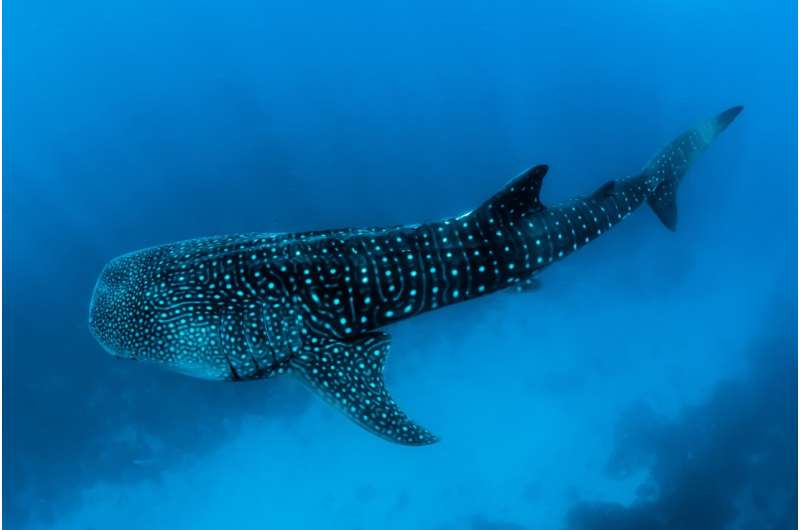June 7, 2023 report
This article has been reviewed according to Science X's editorial process and policies. Editors have highlighted the following attributes while ensuring the content's credibility:
fact-checked
peer-reviewed publication
trusted source
proofread
Whale shark observed bottom-feeding for first time

A shark specialist and a life scientist are reporting on video evidence of a whale shark observed bottom-feeding for the first time. Darren Whitehead, Investigación Tiburones México and Joel Gayford, a life scientist at Imperial College London, received the GoPro video from a tourist who took it during a swimming tour off the coast of Baja California late last year and they have been analyzing its contents. They published their findings in the Journal of Fish Biology.
eat
Whale sharks are the world's biggest fish—they have been observed growing to nearly 19 meters in length. They are typically found in the open ocean, living in the warm waters of the tropics. They are classified as omnivores—they eat mainly fish and shrimp, but have also been seen sucking up plankton such as krill, fish eggs and copepods.
There are two main feeding behaviors: in the first, they simply open their mouths and swim around, filtering out tiny creatures in the water and spitting out the leftovers. In the second, they swim at or near the surface and actively go after specific prey. Such prey is pulled inside and over gill rakers and then swallowed whole. Whale sharks also have more than 300 rows of small teeth, which are not used to feed and have thus far posed no threat to humans. Now it appears that the fish have a third method of eating—sucking in material at the bottom of the sea and spiting out anything that is unpalatable.
This newly observed behavior comes courtesy of one individual whale captured on the video. Filmed in water just six meters deep, the shark pushes its head down to the sea bottom, opens its mouth and begins sucking as it moves across the sea floor. This sucking action, the researchers note, is nearly identical to the type used when foraging at the sea surface. The shark is then seen spitting out residue before resuming bottom feeding.
The researchers suggest the shark seems to be looking for benthic creatures that live just below the sea bottom. They also suggest it appears the specimen in the video is actively attempting to feed on amphipods, tiny crustaceans that live on the seafloor.
More information: Darren A. Whitehead et al, First record of bottom‐feeding behaviour in the whale shark (Rhincodon typus), Journal of Fish Biology (2023). DOI: 10.1111/jfb.15457
Journal information: Journal of Fish Biology
© 2023 Science X Network




















